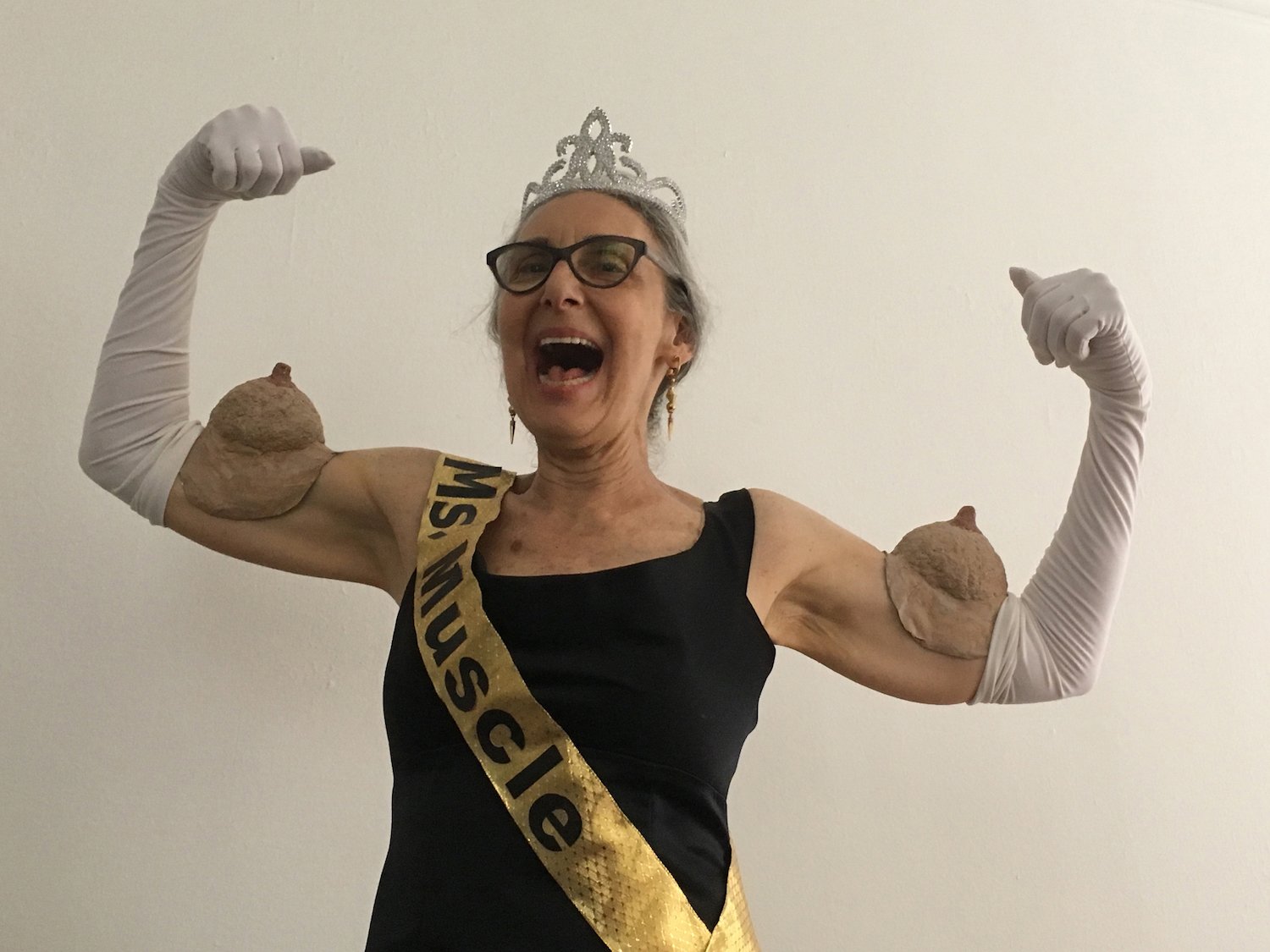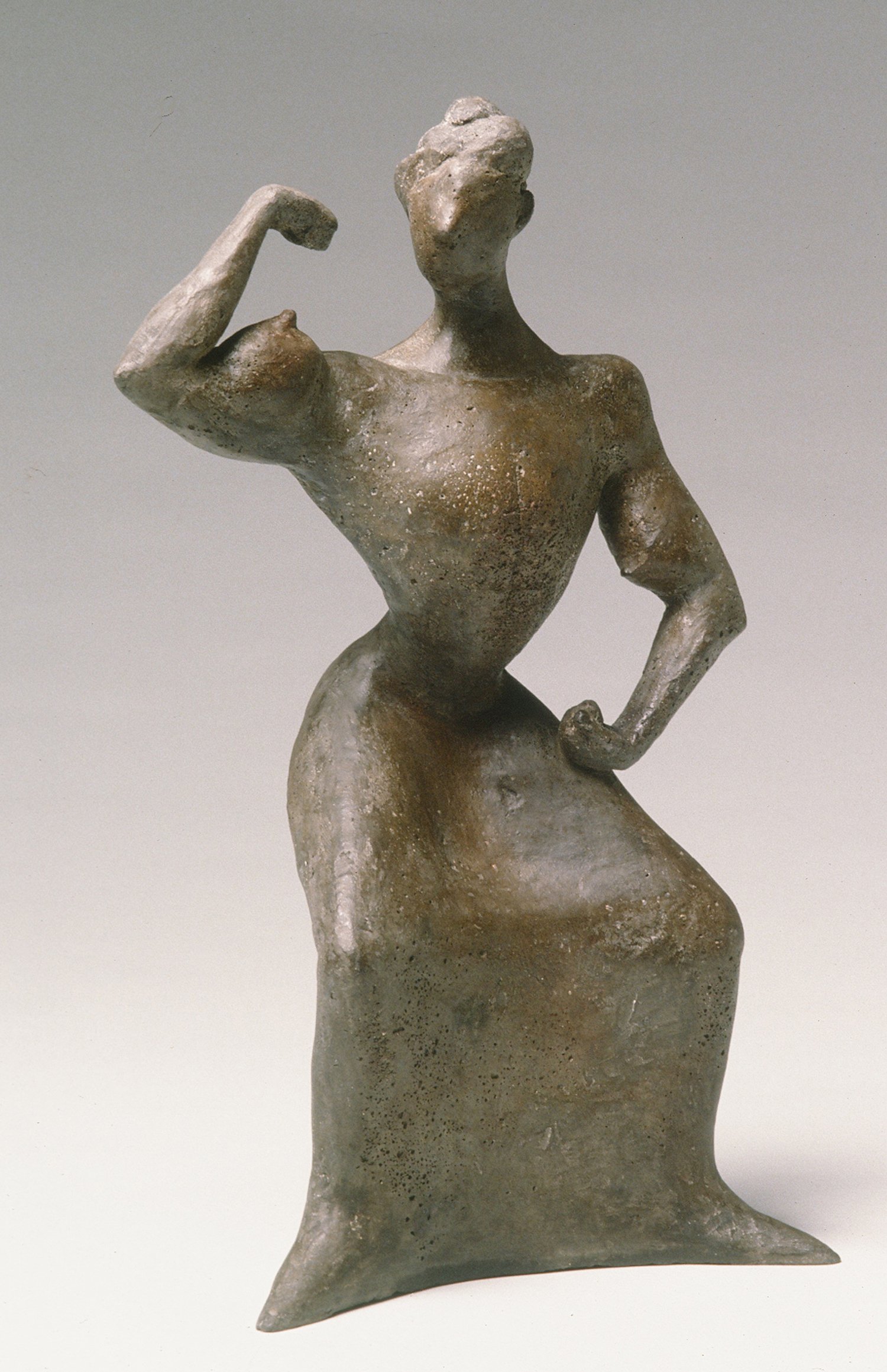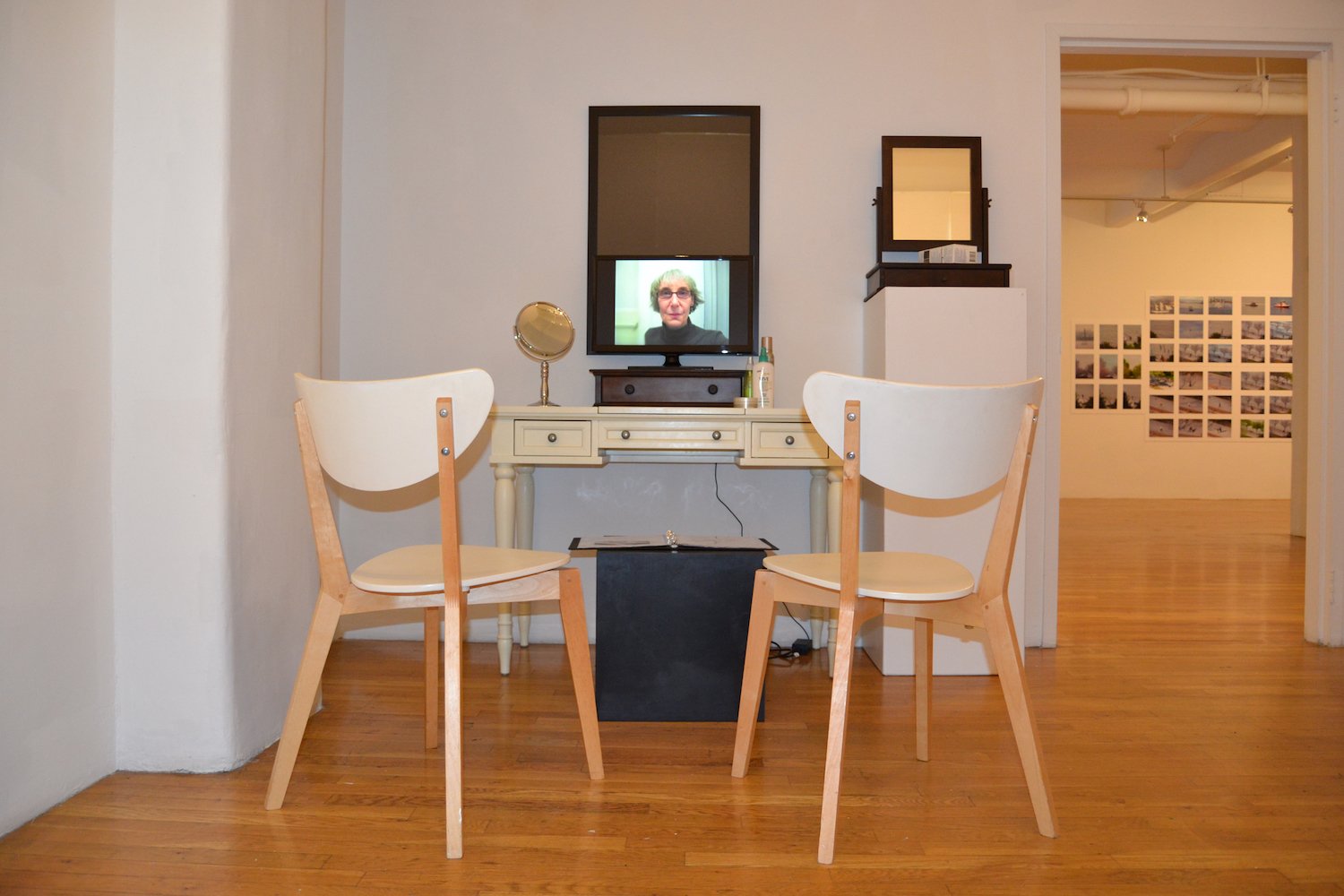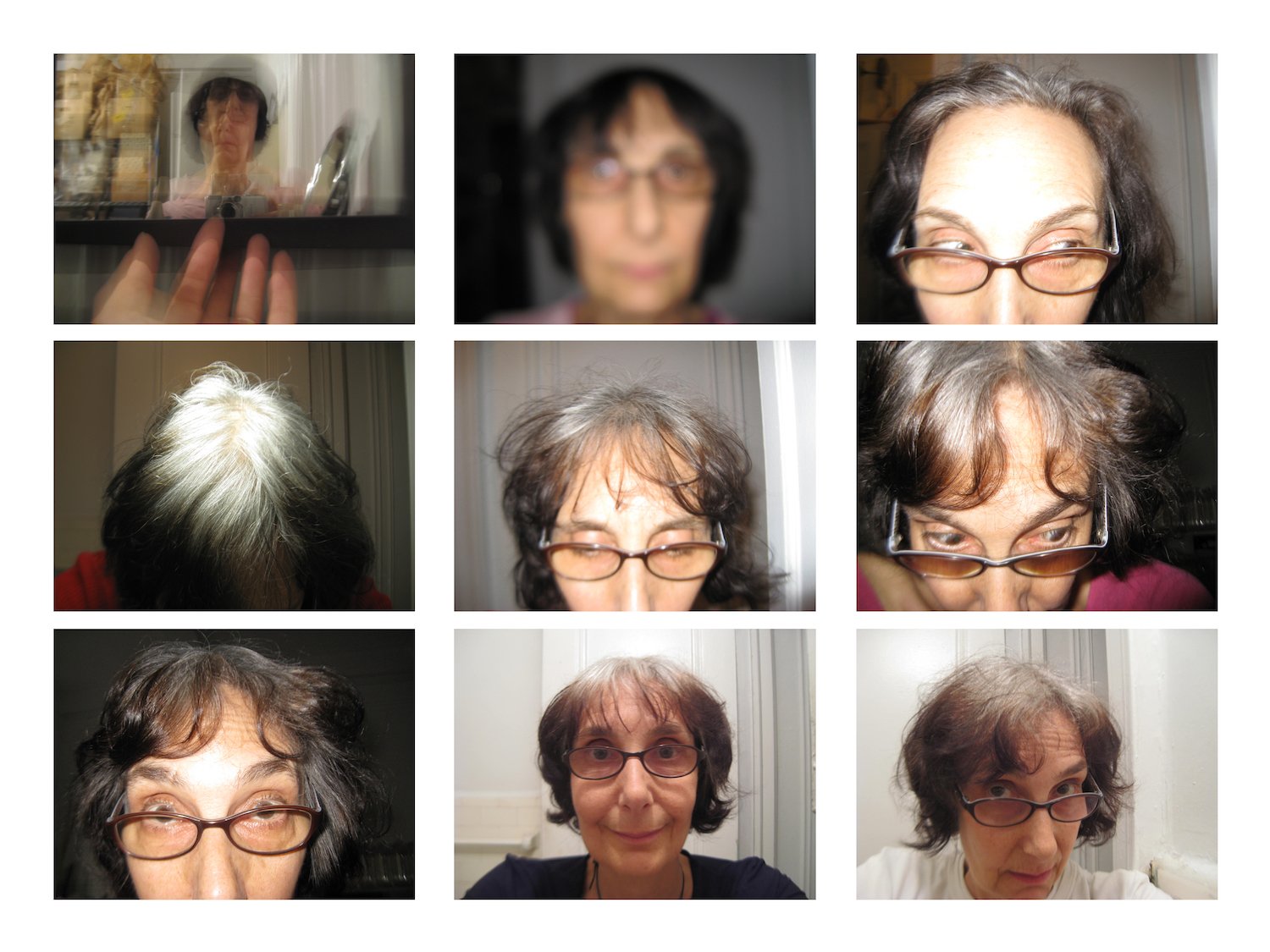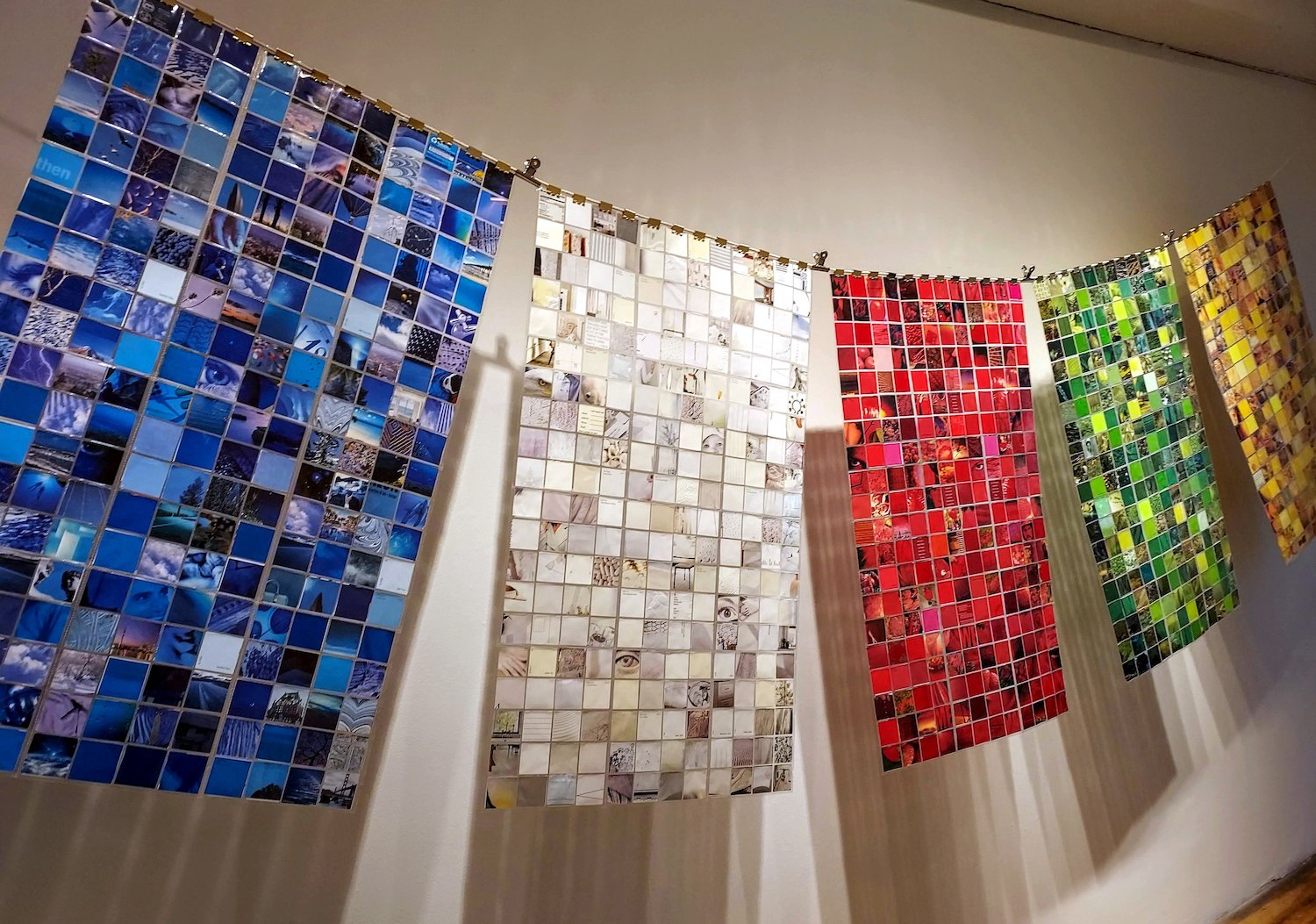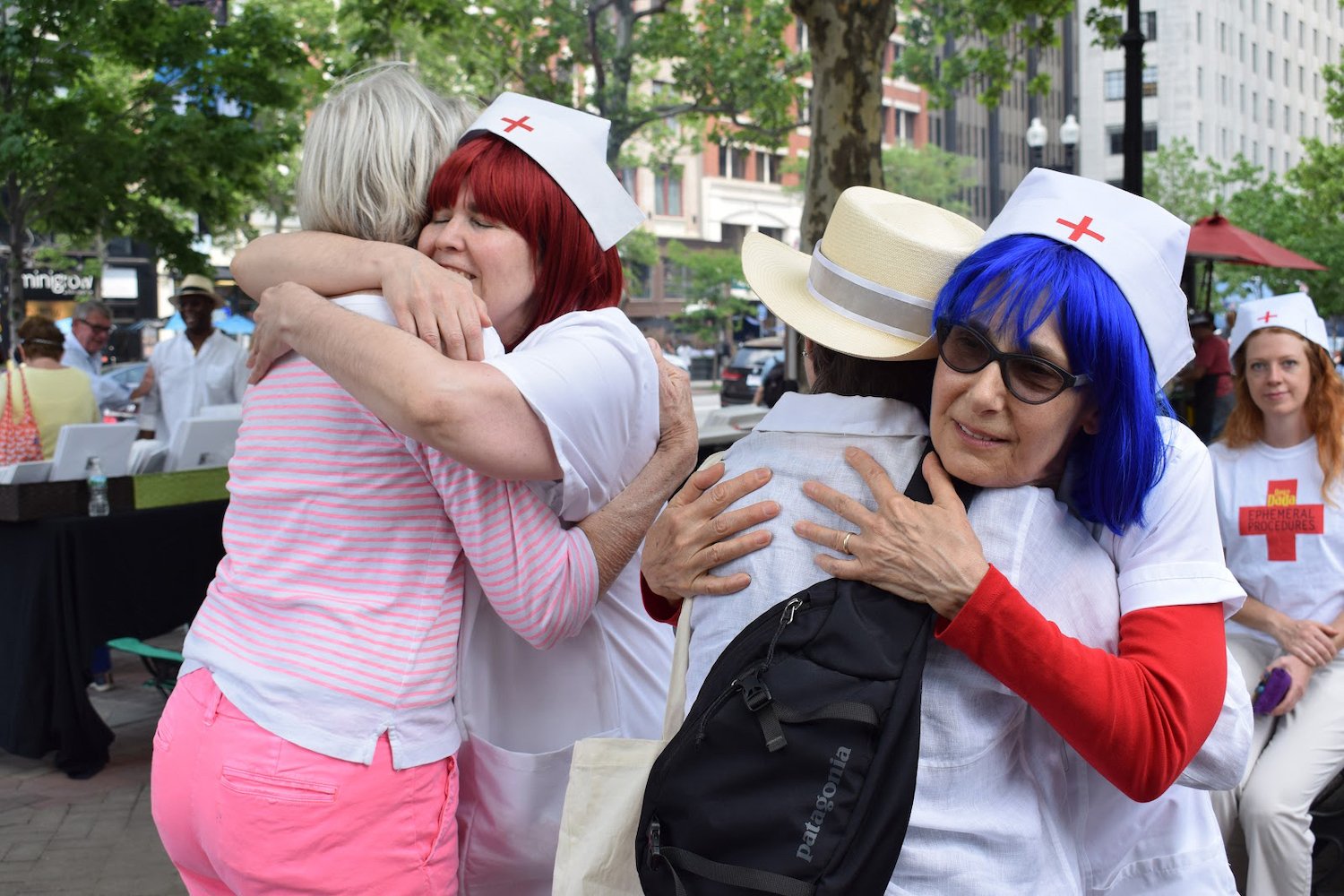Barbara Lubliner
Nicolás Dumit Estévez Raful Espejo Ovalles: Barbara, I do not remember how we met, but here we are, at the time of Covid and major collective shifts. What is in your heart?
Barbara Lubliner: Nicolás, thank you for inviting me to do this Q&I. Years ago, I was introduced to you at the Brooklyn Public Library when you moderated a panel about socially engaged art. But I think we first spoke at the exhibition Enacting the Text / Performing with Words that you curated at the Center for Book Arts. You selected my work as one of 12 winners in The Deface Billy Project II. A few years later you connected me to LuLu LoLo and alerted me to apply to the Art in Odd Places she was curating. You are a natural connector. Art in Odd Places: INVISIBLE was the perfect venue for my performance persona Ms. Muscle! When we exchanged messages about my upcoming prayer flags project, your curiosity led me to look into my soul and the roots of my own spirituality, so I thank you for that too. In my heart is gratitude for you because, even though we don't know each other well, you have been one of my angels! Also in my heart is sadness and hope. I feel like the world needs healing art now more than ever. We are still in the time of Covid after more than two years and there are many disheartening situations: inflation, voter suppression, rising crime, mass shootings, likely turnover of Roe v. Wade, animosity towards others, global warming, war in Ukraine. I am reminded of the 1960s and ’70s which also felt like a time of major shifts and dissension. It was a time of youth culture rebelling against the status quo, war protests, Black power demonstrations, and women's liberation. Perhaps what we are experiencing today are the same issues spiraling back around. At the beginning of the Covid shutdown I felt that change of routine and shared grief would lead people to reevaluate their lives and come up with creative solutions and sane solutions for a more peaceful and equitable world. I am still hopeful.
NDEREO: Can we start with the Art Nurses. I went to medical school for three years and I am still interested in the subject of the body, together with mind and spirit. You too, I think, are invested in this Trinity. I am listening…
BL: Like a lot of my work, art nursing is serious fun. The laughter and imagination it brings to people is healing to mind, body, and spirit. Laughter increases oxygen, imagination reduces stress, art connects and opens the spirit. The Art Nurses are a project of Day de Dada, a performance art collective I am part of. We do interactive performances. As Art Nurses we use Dada and Fluxus inspired diagnostic methods to give art health check-ups and to prescribe imaginative cures. We perform in traditional nurse dresses with nurse caps and bright multicolored wigs. Each nurse has a specialty. Mine is giving Third Eye Exams. I use several different eye charts along with my intuition to playfully engage willing "patients" to share what they see with their third eye. People love the invitation to use their extra perceptivity. Everyone gets a third eye sticker at the end of the exam. Some people stick them right on their foreheads, others keep them as talismans. The Art Nurses have been at a number of venues. We had a residency with Mobius Artists Group in Boston in 2018. Just before the shutdown we did guerrilla performances at the Getty Museum as part of FluxFest California. During Covid, last May we were part of Art in Odd Places: Normal. We wore masks and did more distant cures – we hummed for health, encouraged hugging comfort pets, performed vegetable cures, and sang "Button Up Your Overcoat."
NDEREO: I am tempted to go performance by performance on your website, as many of them relate to where I am now. Tell me about No More Dy(e)ing. During the pandemic I have decided to grow my hair, which is platinum color, as a friend just told me. Can you talk about hair? am asking because this can be such an indicator of aging and gender, at least for me, personally.
BL: Yes, hair is such a big part of the presentation of self in public. It makes me happy to hear you relate to the performance personally. No More Dy(e)ing started at a time when it was difficult for me to make studio work. Much of my time and psychic energy was spent caring for my aging parents. Letting my hair go gray and documenting the process as a yearlong performance was something I could do and something that felt very apt. I photographed myself looking in the mirror each day. As my hair went from black to white, these casual photo sessions documented the transformation and my state, often silly or fatigued, at the time. Every day I faced aging and mortality in private moments while letting go of artifice. A month and half into the project my father died. He had been afflicted with dementia so when he passed he had not been the man I wanted to remember. I gathered with friends and family to memorialize him and share words to keep him alive in our hearts and minds. Losing my father added another layer to No More Dy(e)ing. The dark dye continued to fade, and my natural gray hair grew out as I went about my life. I explained to the curious that my "action" of not dyeing my hair was a yearlong art performance. By the end of 2010 I had thousands of photographs of the transformation. To express the idea of continuum I created an animation with the stills, a video loop meant to play continuously. I added a soundtrack that includes recordings of my daughter at the age of three singing A You're Adorable, my father in his eighties saying he hopes an interview of him will be enjoyed long after he's gone, and Louis Armstrong singing When You're Smiling. Thinking about my father's death and all our ultimate ends, I periodically interrupted the flow of the video with a bell marking the date and name of someone who died during that year. I made a book of their names with a line or two about what they were known for in life. The video loop was shown on a screen atop a vanity table. Just as the conversations during my year of going gray opened people to their own feelings about aging, public presentation of self, and personal choices about hair, the video installation did as well.
Installation photographs and a two-minute excerpt showing the end and then the beginning of the No More Dy(e)ing video are on my website.
The full 15-minute video is on Vimeo.
NDEREO: So much is changing so fast. That is the best I can articulate things at this moment. Binaries are being dismantled. Class and race issues are being challenged. This is quite a period to be in. All of these tremors have been overdue. Where are you in your path as a feminist as of tumultuous 2022?
BL: My Ms. Muscle performance persona feels in sync with today's changing times. She brings together my early feminist work with our world today.
I grew up in a very different time, a very binary world. It was puzzling how my parents treated my younger brother differently and had different expectations of him than of me and my sister. Girls seemed to have narrow choices in the world about how to behave and what they could grow up to be. Boys seemed to have freedom and privilege.
I entered my teens and young adulthood during the women's liberation movement which helped me feel empowered to be fully female and sexual and to exercise control over my body and life. In my twenties I experienced the amazing miracle of being pregnant and the profound experience of giving birth. Afterwards my body nurtured my babies and gave them comfort. I felt connected to being a mammal mother and to the primal world of generations of women.
I expressed my experiences in sculptural form. The figures I made integrated an exploration of the divine feminine in relation to the paradoxical expectations and values for women in the modern world.
Muscle, a sculpture from this series with breast shaped biceps was the starting point for Ms. Muscle who I created to celebrate strong women and the opening of the Brooklyn Museum's feminist wing. I morph into her when I put on fanciful papier-mâché breast shaped biceps.
Ms. Muscle’s enhanced biceps mimic a characteristic associated with male strength, simultaneously because they are bosoms, she proudly exposes a female secondary sexual characteristic that is associated with fertility, nurturing, and sexual arousal. She shows them off by taking the body builder's double biceps pose.
Wearing various garb from exercise wear to evening gowns, Ms. Muscle does interactive walkaround performances engaging people with various chants such as “Love is a muscle” and “Be your biggest and breast self.” She is a spectacle that draws attention and sparks conversation.
For Art in Odd Places Ms. Muscle sang I am woman, hear me roar. ROOAARRRR. She invited people to sing and roar with her. Telling them they could sing, “I am…________(fill-in-the-blank)” to claim the identity they want to energize with their roar.
Ms. Muscle is a cheerleader for women and human values. She is clearly not your typical woman. Her outrageousness encourages you to be fearlessly expressive and proud of who you are along the gender spectrum.
Over the past dozen years, in addition to the Brooklyn Museum, Ms. Muscle has performed at various venues including the Soho Art Parade, Staten Island Museum, Sideshow Gallery, Après Avant-Garde Festival, and in Art in Odd Places.
NDEREO: As a creative and activist who has lived through the upheavals of several key decades in politics, what is your understanding of freedom of expression? I spoke with Martha Wilson a couple of years ago about organizing a panel on this subject.
BL: Freedom of expression is such a difficult issue today with the rampant disinformation that goes on. If a lie is repeated enough times and loudly enough some people will accept it as fact. This is a distortion of the idea of one being able to manifest something through deep spiritual belief. I recently read that despite there being no proof, just over one-third of all voters believe the 2020 election was stolen. Disinformation is disturbing and dangerous. On the other hand, we need to protect the rights of people, especially artists, to freely express themselves. Freedom of expression requires vocabulary that is lacking when the culture does not perceive or recognize your experience. This relates to your earlier question about class, race, and gender issues being challenged. Artists often lead the way with work that gives shape to what has been felt and not expressed. Artwork creates a dialogue that develops vocabulary that facilitates the messy process of understanding one another. I remember what my friend’s father said to us rebellious teenagers, “There is no problem too big or too small that can't be helped by open honest discussion.” My art is my activism. I am always searching for meaning and connection, expressing my experience in a way that is open ended so it will engage the viewer to connect with their own experience.
NDEREO: I know you have done work for Art in Odd Places. I would like to hear more about your creative connection to the streets.
BL: I have a creative connection to context, including the context of the street. I love when art vitally connects to people. It is especially satisfying to have your art lift someone out of their day to day to have an unexpected art experience. My performances with Day de Dada and Art in Odd Places have brought many such encounters with people on the street. My physical artwork can function in a similar way. It is great having it in contexts where the works meaning resonates. During the pandemic shutdown I hung a small set of Prayer Flags – Good Will Wishers at an intersection to spread good will to those walking and hanging out in the street that was closed to traffic. My upcycle plastic bottle installations have activated public spaces with recognizable bottle elements that transform environmental blight into playful structures.Some of my early figurative sculptures have been in enhancing contexts. A Mother and Child casting was the Moms-in-Film Award presented to Marielle Heller in 2017. A Muscle sculpture casting greets visitors to the Ms. Foundation.
NDEREO: Can we move to the spiritual realm? Would you be willing to talk about The Pathwork?
BL: The Pathwork was one of the foundations of my spiritual practice. Since I told you about it, I have become interested in its teachings once again. Your curiosity awakened that in me, for which I thank you. I was introduced to The Pathwork by my soon to be husband in the mid 1970s. We became part of the thriving New York Pathwork Community and attended meetings where Eva Pierrakos went into trance to deliver lectures from a spirit entity called the Guide. Experiencing the lectures firsthand felt like hearing music that spoke directly to a place of inner knowing. The lectures contain metaphysical knowledge and give practical guidance for self-development and personal growth. The Guide said not to take his words at face value, but to take them inside to feel your own conviction. He stresses the importance of facing yourself with utter candor. If there is an area of disharmony in your life, finding your part in creating the situation rather than finding blame with others is nourishing and healing.I credit The Pathwork with opening my heart to love, helping me commit to my lifelong partner, my husband, and to finding my artistic channel.
NDEREO: People, especially in the arts, freak out when they hear me talk about prayer. Meditation is in now and everyone is doing it. Same for hands on healing. I remember the days when I had to whisper this practice. I do pray and so I would like to ask about Prayer Flags.
BL: In 2006, I had the idea to make my first set of Prayer Flags after a project I had been very excited about fell through. Instead of dwelling in anger and blame I decided to meditate on compassion and goodwill as I made the flags. This set is permanently installed at The Fortune Society, an organization that helps formerly incarcerated men and women adjust to life outside the prison system. Last fall when the Omicron variant started surging, wishing to bring positive energy to the Covid weary world, I conceived of making another set of Prayer Flags. The Carter Burden Gallery accepted the proposal for their On the Wall Space. In January I set about transforming discarded materials into the 5-part piece based on Tibetan Buddhist prayer flags and the tradition of hanging colorful cloths to promote blessings of peace, happiness, and good fortune out into the universe. I made the flags, one for each color, by sewing together clear plastic slide sleeve pages. I cut various paper scraps, magazines, catalogs and paint chips into hundreds of 2 x 2 inch squares which I inserted into the plastic pockets that used to hold 35mm slides. I used a wide variety of compelling images that were rich with associations and references to draw people in to find personally meaningful details and to be immersed in the fields of color. All the while in the flow of this labor-intensive work I devoted my heart and mind to prayer and meditation. I imbued the flags with positive energy, meditating on loving kindness and wishing good will out into the world. I used Sharon Salzberg's loving kindness meditation format connecting with myself first and from there connecting with wider and wider circles of compassion and goodwill. In March the Prayer Flags – Good Will Wishers gently released good vibrations in a public space right outside of the Carter Burden Gallery. I am looking into other spaces for them to energize.
NDEREO: Who/what inspires you to keep going during this uncertain period? Although it can be argued that all periods are uncertain, that there is no predictability from second to second. What/who keeps you wanting to get out of bed every morning?
BL: My grandchildren and my family keep me going. I am blessed with three grandchildren who I see every week. I am the matriarch now. I hold the space to honor traditions, mark milestones, celebrate growth, and give love and support.
NDEREO: Why New York City?
BL: I love New York City. I have lived and worked in the same apartment for over 45 years. I have set up my studio in every room except the bathrooms and kitchen.
NDEREO: Thank you for speaking with me. Where are you headed?
BL: Thank you! This weekend I am headed to Figment to perform with Day de Dada. We will be a troupe of Wish Sisters. In my studio practice I am being drawn to working with paper. I am making paper relief sculptures that I call Flower Lips. I am also making monoprints. In the larger sense I am headed to continue on my path. I will continue to be there for loved ones and continue to make art and put it out into the world for those who need to hear it.
Barbara Lubliner is a multi-disciplinary artist, whose work ranges from two-dimensional work on paper, sculpture in a variety of mediums, video and performance art, as well as public art projects and installations. Lubliner incorporates many different mediums and materials, but the core of her artistic practice is the exploration of the female experience. Her work is distinctive in its playful integration of feminist issues and the use of both traditional and upcycled materials.
Lubliner's solo exhibitions include Gibson Gallery Museum, Carter Burden Gallery, and Drawing Rooms. Group exhibitions include Newhouse Center for Contemporary Art, Islip Art Museum, and El Barrio Artspace. Lubliner's outdoor upcycled art installations have been at City Reliquary Museum, Brooklyn's East River State Park, and Manhattan's First Presbyterian Church green space. Performance venues include the Brooklyn Museum, Après Avant Garde Festival, and Art in Odd Places. Lubliner is included in the Brooklyn Museum online Feminist Art Base.
Barbara Lubliner / Related links: Website / IG / IG Ms. Muscle / email
Images above courtesy of Barbara Lubliner
